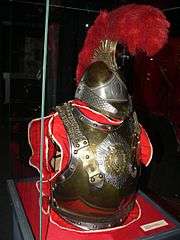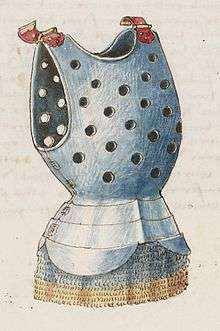Breastplate
A breastplate or chestplate is a device worn over the torso to protect it from injury, as an item of religious significance, or as an item of status. A breastplate is sometimes worn by mythological beings as a distinctive item of clothing.
European
In medieval weaponry, the breastplate is the front portion of plate armour covering the torso. It has been a military mainstay since ancient times and was usually made of leather, bronze or iron in antiquity. By around 1000 AD, solid plates had fallen out of use in Europe and knights of the period were wearing mail in the form of a hauberk over a padded tunic.[1] Plates protecting the torso reappeared in the 1220s as plates directly attached to a knightly garment known as the surcoat.[2][1] Around 1250 this developed into the coat of plates which continued to be in use for about a century.[3][1] True breastplates reappear in Europe in 1340 first composed of wrought iron and later of steel. These early breastplates were made of several plates and only covered the upper torso with the lower torso not being protected by plate until the development of the fauld around 1370.[4][2][5] They were between 1 mm and 2.5 mm thick.[5] In order to prevent the wearer from being cut by their own armour, the design featured outward turned edges that also increased stiffness.[5] In some cases, further strength was added by a ridge running down through the centre of the plate.[5] The first evidence for one-piece breastplates is from an altarpiece in the Pistoia cathedral dated to 1365.[4] Complete, lightweight, one or two-piece breastplates were readily used by the first decade of the 15th century.[4][6] The French term pancier, which became English pauncher and German panzer, was also used.
Bullet-proof vests are the modern descendant of the breastplate.

Asian
A "breastplate" or "breastpiece" was among the clothes of the Jewish High Priest. In the Bible, the word 'breastplate' is used figuratively to describe protecting oneself from unrighteousness (cf. Isaiah 59:17, Ephesians 6:14, etc.).
The 14th century Majapahit Empire manufactured breastplate, called karambalangan. The most notable people using this type of breastplate is Gajah Mada, which is reported by Sundanese patih as wearing golden embossed karambalangan, armed with gold-layered spear, and with a shield full of diamond decoration.[7][8][9] In Kidung Sunda canto 2 verse 85 it is explained that the mantris (ministers or officers) of Gajah Mada wore armor in the form of chain mail or breastplate with gold decoration and dressed in yellow attire.[10]:103
North American
%2C_1880-1900%2C_41.863.jpg)

The hair-pipe breastplates of 19th-century Interior Plains people were made from the West Indian conch, brought to New York docks as ballast and then traded to Native Americans of the upper Missouri River. Their popularity spread rapidly after their invention by the Comanche in 1854. They were too fragile and expensive to be considered armour, and were instead a symbol of wealth during the economic depression among Plains Indians after the buffalo were almost exterminated.[11]
Judaism
According to the biblical Book of Exodus, a square breastplate embedded with 12 different gemstones, each inscribed with the name of a tribe of Israel, was worn by the High Priest. One notable use of the breastplate was to discern God's will through the glint of the gemstones.
See also
- Armour
- Cuirass
- Muscled cuirass
- Lance rest
- Linothorax
- Pteruges
Citations
- Walker, Paul F (2013). The history of armour 1100–1700. Crowood press. pp. 36–38. ISBN 9781847974525.
- Smith 2010, p. 70.
- Smith 2010, p. 69.
- Williams 2003, p. 55.
- Walker, Paul F (2013). The history of armour 1100–1700. Crowood press. pp. 39–41. ISBN 9781847974525.
- Walker, Paul F (2013). The history of armour 1100–1700. Crowood press. p. 43. ISBN 9781847974525.
- Berg, Kindung Sundāyana (Kidung Sunda C), Soerakarta, Drukkerij “De Bliksem”, 1928.
- Nugroho, Irawan Djoko (2011). Majapahit Peradaban Maritim. Suluh Nuswantara Bakti. ISBN 9786029346008.
- Nugroho, Irawan Djoko (6 August 2018). "The Golden Armor of Gajah Mada". Nusantara Review. Retrieved 14 August 2019.
- Berg, C. C., 1927, Kidung Sunda. Inleiding, tekst, vertaling en aanteekeningen, BKI LXXXIII : 1-161.
- David E. Jones (2004). Native North American Armor, Shields, and Fortifications. Austin, TX: University of Texas. pp. 42–44. ISBN 0-292-70170-5.
References
- Smith, R. (2010). Rogers, Clifford J. (ed.). The Oxford Encyclopedia of Medieval Warfare and Military Technology: Volume I. Oxford: Oxford University Press. ISBN 978-0195334036.CS1 maint: ref=harv (link)
- Williams, Alan (2003). The Knight and the Blast Furnace: A History of the Metallurgy of Armour in the Middle Ages & the Early Modern Period. Leiden: Brill. ISBN 978-9004124981.CS1 maint: ref=harv (link)
External links
![]()


